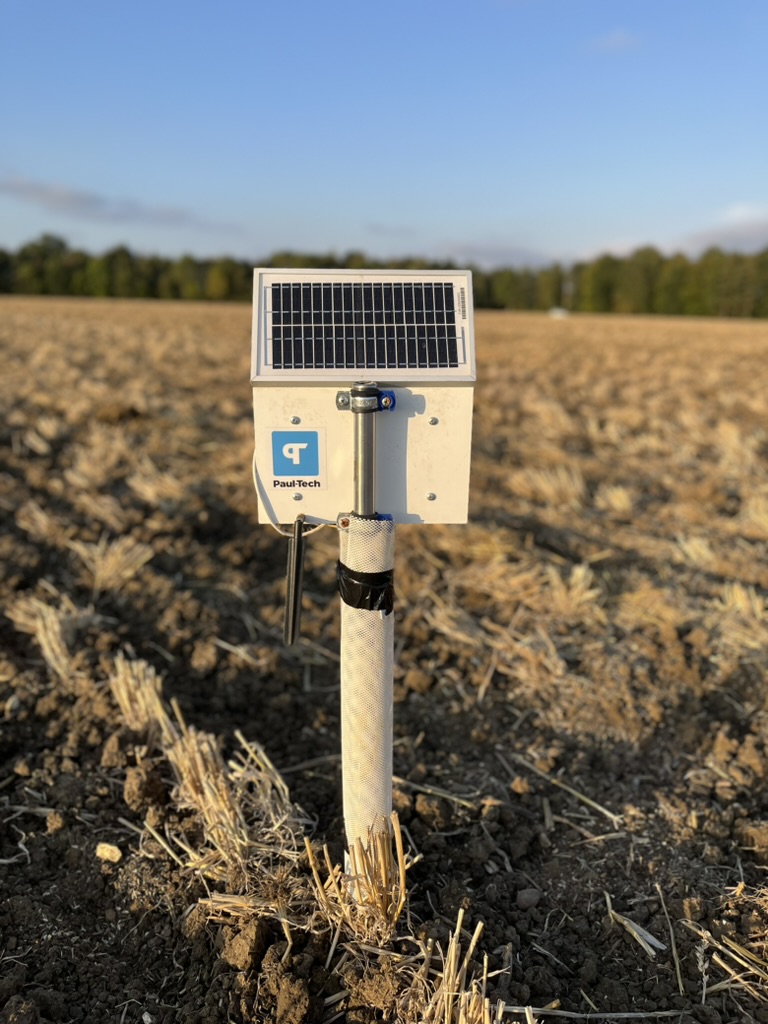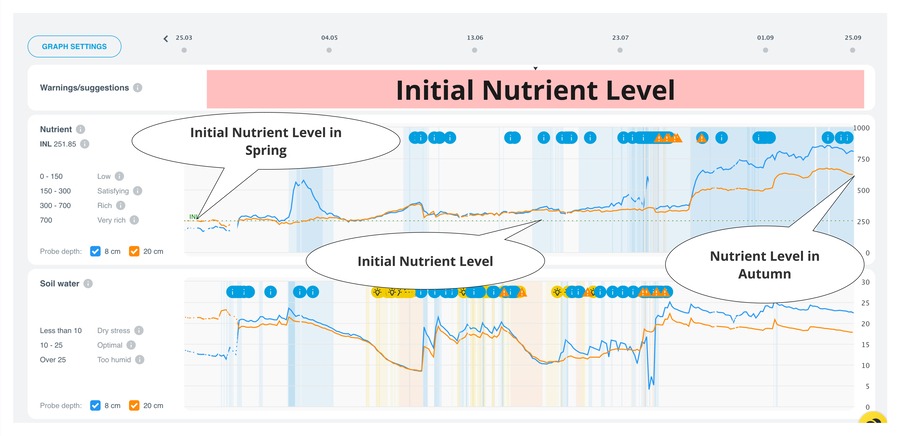
Agricultural success depends on soil condition and monitoring its changes. Autumn is the perfect time to install Paul-Tech’s soil station. It gives farmers a key advantage: monitoring soil nutrients, temperature, and moisture early in spring, before fieldwork starts. This data helps farmers plan soil cultivation and fertilisation tailored to field conditions.
Keeping the soil station in place all season provides continuous valuable data on soil conditions. These insights help farmers assess fields, check nutrient and moisture status, and optimise fertilisation. Over the long term, this helps in crop selection, the use of cover crops, and much more.
Baseline Nutrient Levels – A Key Factor in Fertilisation Decisions
Paul-Tech’s soil station determine the baseline nutrient levels in early spring, before active plant growth begins. The baseline indicates the amount of plant-available nutrients in the soil without mobile nitrogen compounds (nitrate nitrogen, NO3-N). This data helps farmers make more precise fertilisation decisions, reducing the risk of over-fertilisation and helping to improve yields.

Monitoring Nutrient Dynamics from Autumn to Spring: A soil station installed in autumn collects data showing how plant-available nutrient reserves change from autumn to spring. Data from sensors at various depths allows farmers to assess nutrient leaching, helping them understand the properties of their specific soil and plan fertilisation and other tasks accordingly.
Nitrogen Consumption and Leaching: Nitrogen is one of the most mobile nutrients in the soil, meaning that nitrogen added in autumn is either absorbed by plants or leaches into the lower soil layers. Soil stations allow for monitoring nitrogen consumption and behaviour in the soil, leading to better fertilisation decisions. This is especially important when using slurry on fields.
Soil Temperature and Moisture – Critical Factors in Spring Fieldwork Planning
Soil stations continuously measure soil temperature and moisture, providing crucial data for scheduling fieldwork and sowing. Accurate assessment of temperature and moisture helps farmers ensure the best growing conditions for plants and reduces risks associated with poor timing.
Determining the Start of the Growing Season: Soil station data helps determine the start of the growing season and the optimal sowing time, reducing the risk of frost damage and ensuring more favourable growing conditions for crops.
Field Bearing Capacity and Moisture: The moisture values measured by the stations help assess when the soil has the right moisture levels for fieldwork. This is particularly important for heavier clay soils, where the suitable moisture range for working the soil is quite narrow.
Monitoring Crop Overwintering and Assessing Soil Conditions
Paul-Tech’s soil station provide valuable data during the winter period, when crop overwintering depends on changes in soil temperature and moisture regimes. The stations monitor soil freezing and thawing processes, providing information on how winter has affected crops and soil structure.
Crop Overwintering and Freeze-Thaw Cycles: Soil station data reveals the impact of freezing and thawing on soil conditions and plant root systems, aiding in decision-making for spring fieldwork.
Collecting Data Throughout the Season – Continuous Insights into Soil Conditions and Growing Conditions
Continuous Monitoring of Nutrient Uptake: The data shows precisely when nutrients from fertilisers become available to plants, when they are consumed, and how nutrient movement within the soil affects yields. This helps avoid nutrient wastage and optimises fertilisation decisions.
Optimising Plant Health and Yields: Full-season data helps farmers make informed decisions at every growth stage, ensuring plants receive the necessary nutrients on time. This leads to healthier crops and higher yields.
Preventing Risks and Early Intervention: Continuous data collection enables the early identification of potential issues, such as nutrient deficiencies or excessive moisture, allowing for swift and effective intervention.
Data Accessibility – An Automated and Simple Process
Many farmers ask how much effort is required to access soil station data. Paul-Tech’s solution makes this process convenient and automated. Once the soil station is installed, data is automatically sent to the user interface every two hours—no manual downloads or on-site measurements are required. This means farmers can focus on what matters—farming and increasing yields—while the soil stations handle data collection and transmission.
Book a Free Demo Today – Discover the Best Solution for Your Fields with Paul-Tech
If you want to see how Paul-Tech’s soil stations can improve the productivity and quality of your fields, book a free demo today! Our team will introduce you to our technology and help you find the best solution tailored to your field conditions. This is a great opportunity to see how accurate data collection and analysis can help make better, science-based decisions in agriculture.